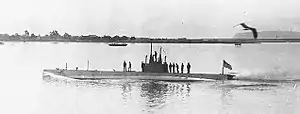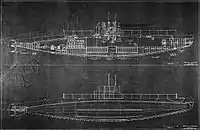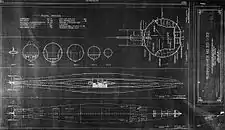 USS F-2 underway in San Diego harbor, California | |
| History | |
|---|---|
| Name | USS F-2 |
| Builder | Union Iron Works, San Francisco, California |
| Laid down | 23 August 1909, as USS Barracuda |
| Launched | 19 March 1912 |
| Commissioned | 25 June 1912 |
| Decommissioned | 16 March 1922 |
| Renamed | USS F-2, 17 November 1911 |
| Fate | Sold, 17 August 1922 |
| General characteristics | |
| Type | F-class submarine |
| Displacement |
|
| Length | 142 ft 7 in (43.5 m) |
| Beam | 15 ft 5 in (4.7 m) |
| Draft | 12 ft 2 in (3.7 m) |
| Installed power |
|
| Propulsion |
|
| Speed |
|
| Range |
|
| Test depth | 200 feet (61.0 m) |
| Complement | 22 officers and enlisted men |
| Armament | 4 × bow 18 inch (450 mm) torpedo tubes |
USS F-2 (SS-21) was an F-class submarine built for the United States Navy during the 1910s.
Description
The F-class boats had a length of 142 feet 7 inches (43.5 m) overall, a beam of 15 feet 5 inches (4.7 m) and a mean draft of 12 feet 2 inches (3.7 m). They displaced 330 long tons (340 t) on the surface and 400 long tons (410 t) submerged. The F-class submarines had a crew of 1 officer and 21 enlisted men. They had a diving depth of 200 feet (61.0 m).[1]
For surface running, the boats were powered by two 390-brake-horsepower (291 kW) NELSECO diesel engines, each driving one propeller shaft. When submerged each propeller was driven by a 310-horsepower (231 kW) electric motor. They could reach 14 knots (26 km/h; 16 mph) on the surface and 11.25 knots (20.84 km/h; 12.95 mph) underwater. On the surface, the boats had a range of 2,500 nautical miles (4,600 km; 2,900 mi) at 11 knots (20 km/h; 13 mph)[1] and 100 nmi (190 km; 120 mi) at 5 knots (9.3 km/h; 5.8 mph) submerged.[2]
The F-class submarines were armed with four 18-inch (450 mm) torpedo tubes in the bow, no reloads were carried.[2]
Construction and career
The boat was named Barracuda when she was laid down by Union Iron Works of San Francisco, California, but was renamed on 17 November 1911. She was launched on 19 March 1912 sponsored by Miss A. R. Rolph, daughter of James Rolph, the mayor of San Francisco, and commissioned on 25 June 1912.
F-2 joined the 1st Submarine Group, Pacific Torpedo Flotilla, in operations between San Diego, California, and San Pedro, Los Angeles out of San Pedro Submarine Base, the Flotilla's base. She continued to play an important part in developing tactics and coordinating the use of undersea craft with the fleet during an extended training period in the Hawaiian Islands's Naval Submarine Base Pearl Harbor from August 1914-November 1915.
After lying in ordinary at Mare Island Naval Shipyard from 16 March 1916 – 13 June 1917, F-2 became flagship of Division 1, Submarine Force, Pacific Fleet. Returning to operations out of San Pedro, she participated in surface and submerged exercises, torpedo-proving practice, experiments in balancing at various depths, and trained prospective crews of new submarines. On 18 September 1919, she was placed in reserve commission at San Pedro to be used in elemental school work until decommissioned at Mare Island on 16 March 1922. She was sold on 17 August.


Notes
References
- Friedman, Norman (1995). U.S. Submarines Through 1945: An Illustrated Design History. Annapolis, Maryland: Naval Institute Press. ISBN 1-55750-263-3.
- Gardiner, Robert & Gray, Randal, eds. (1985). Conway's All the World's Fighting Ships 1906–1921. Annapolis, Maryland: Naval Institute Press. ISBN 0-85177-245-5.
This article incorporates text from the public domain Dictionary of American Naval Fighting Ships. The entry can be found here.
External links
- Photo gallery of USS F-2 at NavSource Naval History